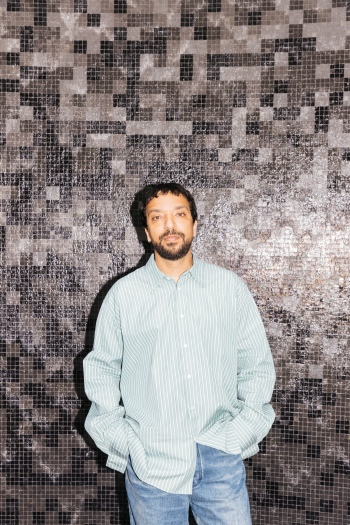James Gregory Atkinson
Web presence
Instagram: https://www.instagram.com/toxithegoat/
Werke
6 Friedberg-Chicago
Date
2021
4K video with sound, 6 minutes 18 seconds loop (audible via media guide system).
Description
6 Friedberg-Chicago draws inspiration from contemporary R&B music videos. The young men featured—captured on a segregated basketball court and in a defunct, blacklit Burger King—are united by their Afro-German experience. Their shared identity is further complicated by their biographical ties to the crumbling Ray Barracks, a former U.S. Army base, where Atkinson’s father was stationed. Now a silent ruin, this decommissioned site becomes an excavation of personal and collective memory, a buried layer where history and identity are unearthed, and the story unfolds through fragments and echoes of a lost past.
With His Head Held High. Re: STAND AND FALL
Date
2023
James Gregory Atkinson, Head Held High. Re: STAND AND FALL. (Original German title: Mit erhobenem Kopf. Re: STAND UND FALL.)
Bronze Askari figure (identity unknown), Part 1 of 3, Adolf Kürle: Wissmann Memorial, Dar es Salaam, Tanzania/Hamburg, Germany, 1905
Description
In his research-based exhibition projects, German-American artist James Gregory Atkinson combines elements of social and political history with his autobiography to examine the absence of Afro-German experiences within dominant narratives of race, identity, and nationality in Germany. By connecting archives, locations, bodies, and performative practices as historical carriers to the present realities of Black diasporic life, Atkinson proposes alternative perspectives on transhistorical Blackness. In Head Held High. Re: STAND AND FALL (original German title: Mit erhobenem Kopf. Re: STAND UND FALL) James Gregory critically deconstructs the toppled monument of Hermann von Wissmann. The memorial used to show three bronze figures with Wissmann on top, looming over an Askari soldier and a fallen lion at ground level. In this setting the Askari remained nameless and devoid of identity, his story lost to history. This imagery reinforced a clear racial hierarchy that underscored the subjugation faced by colonized peoples, perpetuating a legacy that dehumanized Black identities and emphasized the urgent need to confront and reclaim these histories. Atkinson now focuses on the Askari alone and his upright representation with his head held high, to highlight and infiltrate the complexities of colonial identity and resistance.
Time Capsule: Toxi Lives Differently
Date
2024
Time Capsule Toxi Lives Differently (Original German title: Zeitkapsel Toxi lebt anders), 2024
Photography, magazines, documents, books, oil on canvas, various materials.
Courtesy of the artist, Kirsten Köhler-Forsbach, and the Collection of Theodor Wonja Michael at the Documentation Center and Museum on Migration in Germany (DOMiD), Eemil Doerstling, German Historical Museum Berlin.
Description
The Time Capsule: Toxi Lives Differently (original German title: Zeitkapsel Toxi lebt anders), 2024, integrates Emil Doerstling’s 1890 painting Schwarzer preußischer Soldat mit einer weißen Frau, Allegorie auf die preußische Kolonialpolitik Deutsche Historische Museum. This work delves into themes of race, identity, and collective memory, contrasting the painting’s idealized portrayal of intimacy with the harsh realities faced by Black individuals in the German Reich and (post-)Nazi Germany. Starting in 1937, efforts were made to obscure the forced sterilization of children born to French colonial soldiers from North and West Africa and White German women. By 1952 a public debate in the Bundestag vilified these children, treating them as a visible problem for Germany. Films like Toxi, released in the same year, sold the reunion of Afro-German children with their African American fathers in the United States as the ideal solution to this historical glitch. Time Capsule: Toxi Lives Differently collects archival materials from this period, exposing the so-called brown baby adoption program as a mass deportation initiative. It includes magazines, images from the artist’s family albums, and various ephemera, effectively pointing back to the protagonists of 6 Friedberg-Chicago.


